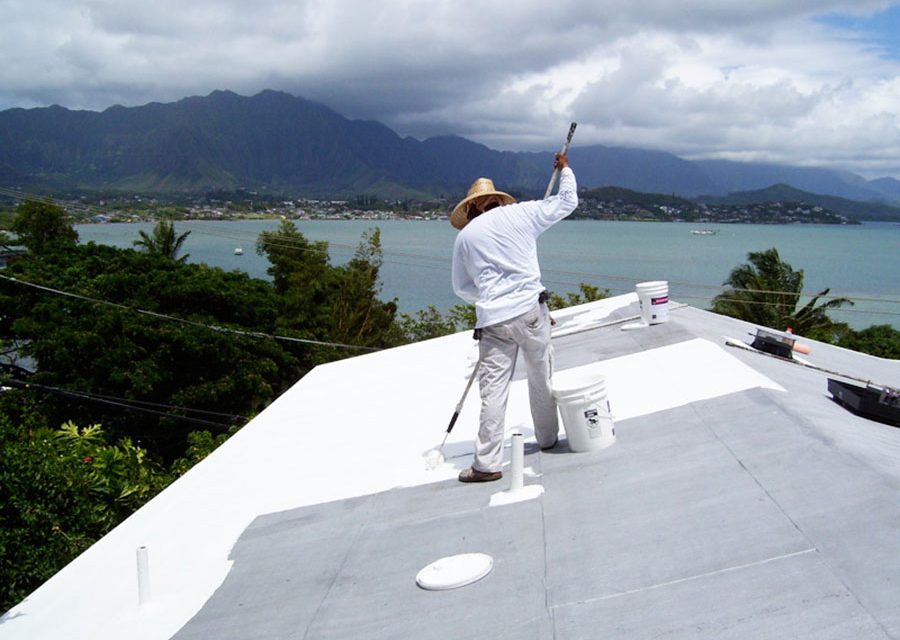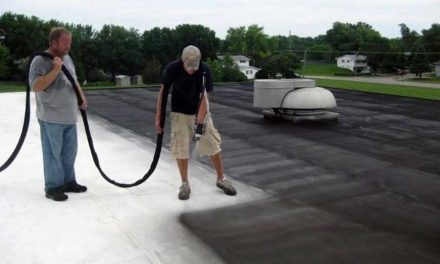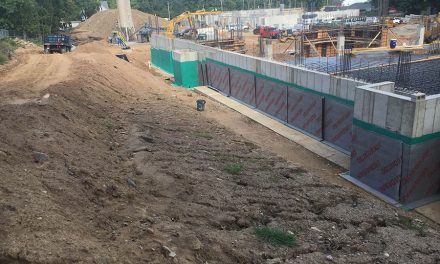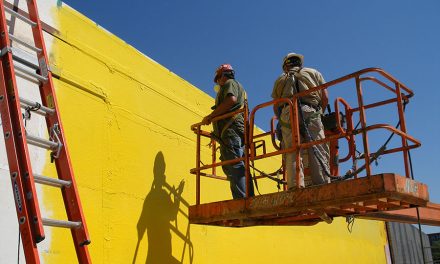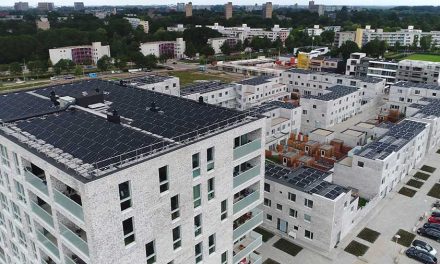Two totally different roof systems are described as “green” roofs.
Vegetated, or garden roofs, are built like a ballasted roof system, using lightweight growing medium to hold the membrane and insulation in place, and are typically planted with drought-tolerant plants. These roofs are literally green, and offer a host of environmental benefits, including increased energy efficiency, decreased stormwater runoff, and increased roof lifespan. They also provide intangible and aesthetic benefits.
Cool, or reflective, roofing is also considered environmentally friendly. These are typically white or light-colored single-ply membranes, although light-colored fluid-applied membranes and coatings also exist.
Recently, the U.S. Department of Energy conducted a study to determine how these two roof types compare to typical dark-colored roofing on flat and low-slope commercial buildings. The data was limited strictly to economic factors, including lifespan, initial installation cost, and maintenance. The research was conducted by the Lawrence Berkeley National Laboratory.
The report, titled Economic Comparison of White, Green, and Black Flat Roofs in the United States by Julian Sproul, Benjamin Mandel, and Arthur Rosenfeld of Berkeley Lab, and Man Pun Wan of Nanyang Technological University in Singapore, provides a direct economic comparison of these three roof types. The full-length version of the report is available online. The authors analyzed 22 commercial flat roof projects in the United States in which two or more roof types were considered. The researchers assumed a 20-year service life for white and black roofs and a 40-year service life for green roofs, and planned to look at the economics using a a 50-year life cycle cost analysis.
Traditional dark roofing, regardless of composition, had the highest environmental cost, and the report authors recommend it should be phased out. White roofing finished first, based on the economics-only approach of the study.
Art Rosenfeld, a Berkeley Lab Distinguished Scientist Emeritus and former Commissioner of the California Energy Commission, acknowledges that the economic analysis does not capture all of the benefits of a green roof. For example rooftop gardens provide stormwater management, an appreciable benefit in cities with sewage overflow issues, while helping to cool the roof’s surface as well as the air. Green roofs may also give building occupants the opportunity to enjoy green space where they live or work.

Garden roofs such as this one installed on the Chicago City Hall are far more efficient than traditional black roofing systems.
However, based strictly on economic factors, reflective roofing was clearly the most beneficial. “White roofs win based on the purely economic factors we included, and black roofs should be phased out,” said Rosenfeld.
Benjamin Mandel, who co-authored the report, says, “We leave open the possibility that other factors may make green roofs more attractive or more beneficial options in certain scenarios,” said Mandel, a graduate student researcher at Berkeley Lab. “The relative costs and benefits do vary by circumstance.”
According to the study, white roofs reflect roughly three times more sunlight back into the atmosphere than planted roofs, and therefore absorb less sunlight at earth’s surface. By absorbing less sunlight than either green or black roofs, white roofs offset a portion of the warming effect from greenhouse gas emissions.
“Both white and green roofs do a good job at cooling the building and cooling the air in the city, but white roofs are three times more effective at countering climate change than green roofs,” says Rosenfeld.

A Caveat
Lloyd Alter, a respected writer on green building, points out that the Berkeley Lab economic report may not represent the full picture, especially the claim that “white roofs are three times more effective at countering climate change.” He says, “The white roof reflects more heat, but the green roof soaks it up. Not all of that reflected light is going straight up; a lot goes on to other buildings and increases their air conditioning load. How much sunlight and carbon dioxide is absorbed by CO2-eating plants? How much heat energy is absorbed in the transpiration of moisture from those plants? How much energy is saved because of the extra insulation and thermal mass of the green roof? It is simply not true that ‘green roofs do not offset climate change.’”
Mandel says, “We’ve recognized the limitations of an analysis that’s only economic. And while the economic results are interesting, it also highlights the need for a more comprehensive analysis to include factors such as health, stormwater management, HVAC sizing, and other issues. We would want to include these other factors in any future study.”
Interestingly, the University of Texas at Austin conducted a similar roof study in 2008 that took many of these factors into account. They found that green roofs were significantly cooler, saying “Where black and white roof membrane temperatures reached 68°C and 42°C respectively, equivalent green roof membrane temperatures ranged between 31–38°C. Similarly, when internal temperatures reached 54°C under black roofs, 50°C under white roofs, green roof internal temperatures ranged from 36–38°C.”
High Initial Costs
Julie Chao, summarizing the report, says, “The 50-year life-cycle cost analysis found that even the most inexpensive kind of green roof (with no public access and consisting of only sedum, or prairie grass) costs $7 per square foot more than black roofs over 50 years, while white roofs save $2 per square foot compared to black roofs. In other words, white roofs cost $9 per square foot less than green roofs over 50 years, or $0.30 per square foot each year.

The costs and benefits difference stack that has the highest net present value shows the roof type that is most cost-effective. Parentheses around dollar values indicate negative values.
“The researchers acknowledge that their data are somewhat sparse but contend that their analysis is valuable in that it is the first to compare the economic costs and energy savings benefits of all three roof types.”
Mandel says, “When we started the study it wasn’t obvious that white roofs would still be more cost-effective over the long run, taking into account the longer service time of a green roof.”
Health Issues
The study did find that black roofs pose a major health risk in cities that see high temperatures in the summer. “In Chicago’s July 1995 heat wave a major risk factor in mortality was living on the top floor of a building with a black roof,” Rosenfeld said.
For that reason, he believes this latest study points out the importance of government policymaking. “White doesn’t win out over black by that much in economic terms, so government has a role to ban or phase out the use of black or dark roofs, at least in warm climates, because they pose a large negative health risk,” he said.
Rosenfeld, who started at Berkeley Lab in the 1950s, is often called California’s godfather of energy efficiency for his pioneering work in this area. He was awarded a National Medal of Technology and Innovation by President Obama in 2012, one of the nation’s highest honors.
Best Value
Rosenfeld has been a supporter of reflective “cool” roofs, including white roofs, as a way to reduce energy costs and address global warming. He was the co-author of a 2009 study in which he estimated that increasing reflective roofs and pavements worldwide could offset as much as 44 billion tons of CO2 emissions. Computer modeling software later verified that cool roofs could offset the equivalent of 20 years worth of exhaust from 300 million cars.
Reflective cool roofing is also one of the fastest-growing roof types. According to Chao, “They are used in about two-thirds of new roof or re-roof installations in the western U.S. In California they have been part of prescriptive requirements of the Title 24 Building Energy Efficiency Standards since 2005 for all new nonresidential, flat roof buildings (including alterations and additions).”

LEED Requirements
LEED v4, the most popular green building program, offers credit for both white and green roofs. According to the official scoring criteria on the U.S. Green Building Council website, “high-reflectance and vegetated roofs” both qualify.
To qualify under the high-reflectance option, the white roof must be installed over a minimum of 75% of the roof area of all new buildings within the project, and have a SRI [solar reflectance index] of 78 (for low slope roofs) or 29 for roof pitches greater than 2:12.
Under the green roof option, the vegetated roof must cover at least 50% of the roof area of all new buildings within the project.
Combinations of SRI-compliant and vegetated roofs are also acceptable.
Spring 2016 Back Issue
$4.95
Rooftop Decking
Basement Remodels and Emergency Egress
Waterproofing and Geofoam
AVAILABLE AS DIGITAL DOWNLOAD ONLY
Description
Description
Rooftop Decking
These case studies outline the challenges and solutions to installing flat rooftop decking on both residential and commercial projects.
Basement Remodels and Emergency Egress
Basement contractors and waterproofers can increase profitability by adding egress installation to their services. Here’s how to make sure both the code and the owners’ budget are satisfied.
Waterproofing and Geofoam
Rigid EPS foam insulation is frequently found in roofing assemblies. But it can be encountered in a number of other waterproofing applications as well.
Additional Info
Additional information
| Magazine Format | Digital Download Magazine, Print Mailed Magazine |
|---|

